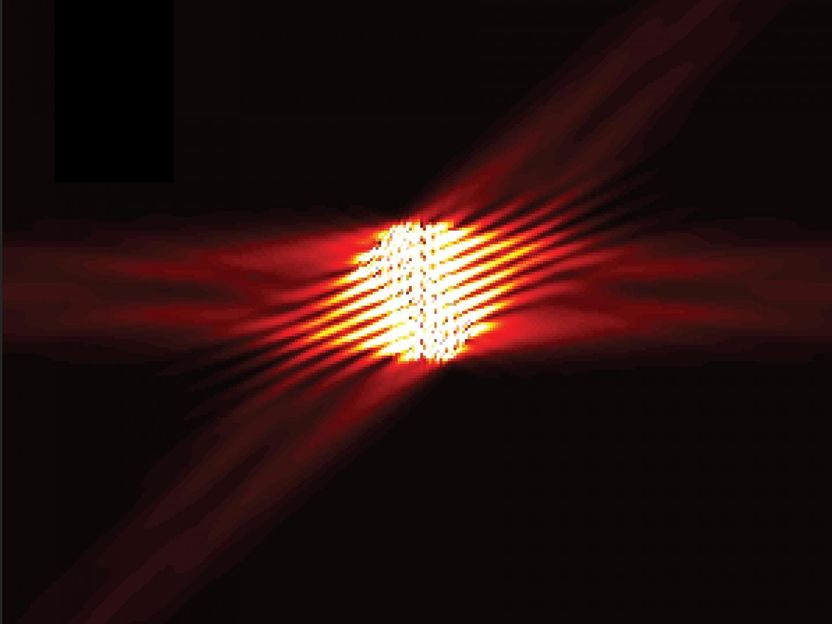Novel metasurface revolutionizes ubiquitous scientific tool
Scientists rely on polarimeters to make measurements. While ubiquitous, many polarimeters currently in use are slow, bulky and expensive.

Light from an optical fiber illuminates the metasurface and is scattered in four different directions. The intensities are measured by four detectors. From this measurement the state of polarization of light is detected.
Photo courtesy of the Capasso Lab/Harvard SEAS
Now, researchers at the Harvard John A. Paulson School of Engineering and Applied Sciences and Innovation Center Iceland have built a polarimeter on a microchip, revolutionizing the design of this widely used scientific tool.
"We have taken an instrument that can reach the size of a lab bench and shrunk it down to the size of a chip," said Federico Capasso, the Robert L. Wallace Professor of Applied Physics and Vinton Hayes Senior Research Fellow in Electrical Engineering, who led the research. "Having a microchip polarimeter will make polarization measurements available for the first time to a much broader range of applications, including in energy-efficient, portable devices."
"Taking advantage of integrated circuit technology and nanophotonics, the new device promises high-performance polarization measurements at a fraction of the cost and size," said J. P. Balthasar Mueller, a graduate student in the Capasso lab and first author of the paper.
Harvard's Office of Technology Development has filed a patent application and is actively exploring commercial opportunities for the technology.
Capasso's team was able to drastically reduce the complexity and size of polarimeters by building a two-dimensional metasurface -- a nanoscale structure that interacts with light. The metasurface is covered with a thin array of metallic antennas, smaller than a wavelength of light, embedded in a polymer film. As light propagates down an optical fiber and illuminates the array, a small amount scatters in four directions. Four detectors measure the intensity of the scattered light and combine to give the state of polarization in real time.
"One advantage of this technique is that the polarization measurement leaves the signal mostly intact," said Mueller. "This is crucial for many uses of polarimeters, especially in optical telecommunications, where measurements must be made without disturbing the data stream."
In telecommunications, optical signals propagating through fibers will change their polarization in random ways. New integrated photonic chips in fiber optic cables are extremely sensitive to polarization, and if light reaches a chip with the wrong polarization, it can cause a loss of signal.
"The design of the antenna array make it robust and insensitive to the inaccuracies in the fabrication process, which is ideal for large scale manufacturing," said Kristjan Leosson, senior researcher and division manager at the Innovation Center and coauthor of the paper.
Leosson's team in Iceland is currently working on incorporating the metasurface design from the Capasso group into a prototype polarimeter instrument.
Chip-based polarimeters could for the first time provide comprehensive and real-time polarization monitoring, which could boost network performance and security and help providers keep up with the exploding demand for bandwidth.
"This device performs as well as any state-of-the-art polarimeter on the market but is considerably smaller," said Capasso. "A portable, compact polarimeter could become an important tool for not only the telecommunications industry but also in drug manufacturing, medical imaging, chemistry, astronomy, you name it. The applications are endless."
Original publication
Other news from the department science

Get the chemical industry in your inbox
By submitting this form you agree that LUMITOS AG will send you the newsletter(s) selected above by email. Your data will not be passed on to third parties. Your data will be stored and processed in accordance with our data protection regulations. LUMITOS may contact you by email for the purpose of advertising or market and opinion surveys. You can revoke your consent at any time without giving reasons to LUMITOS AG, Ernst-Augustin-Str. 2, 12489 Berlin, Germany or by e-mail at revoke@lumitos.com with effect for the future. In addition, each email contains a link to unsubscribe from the corresponding newsletter.


























































